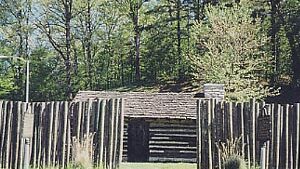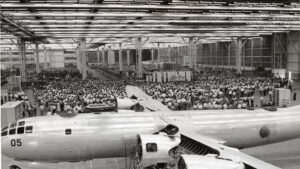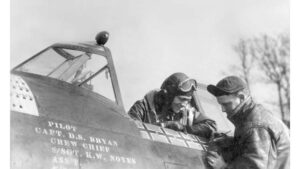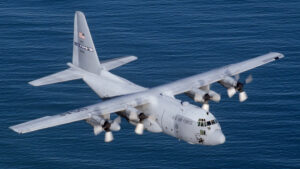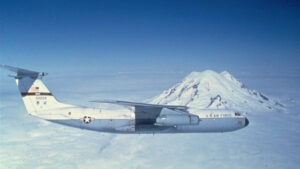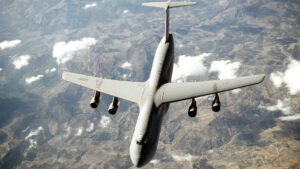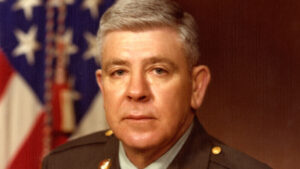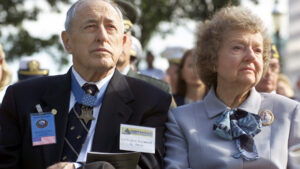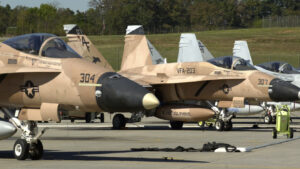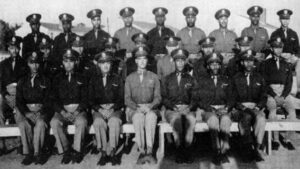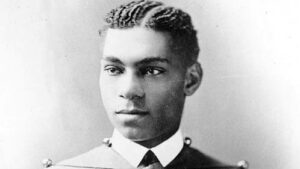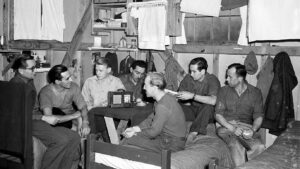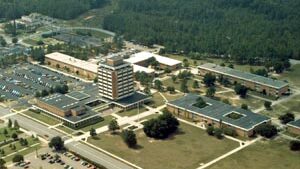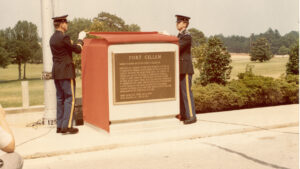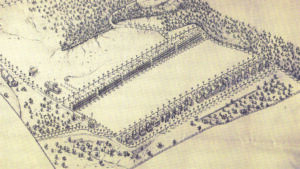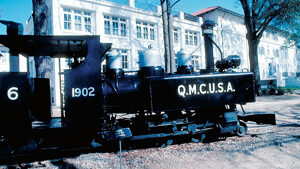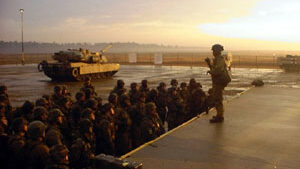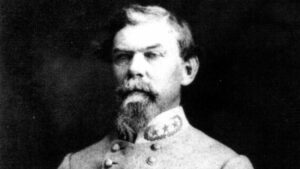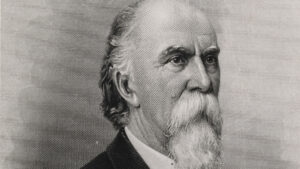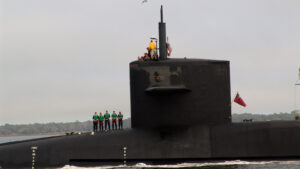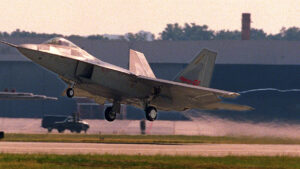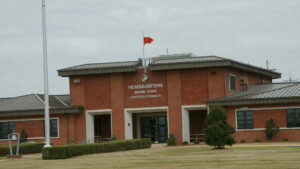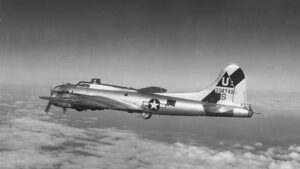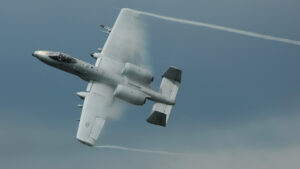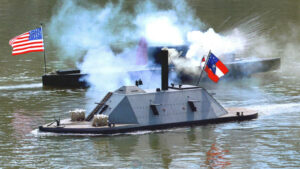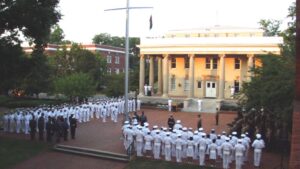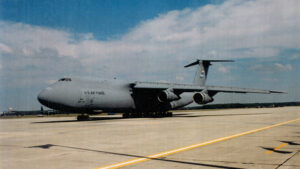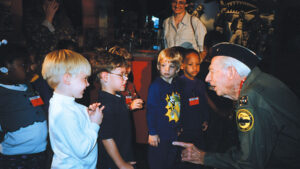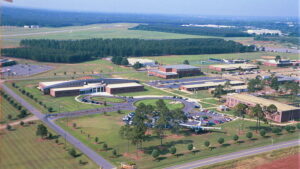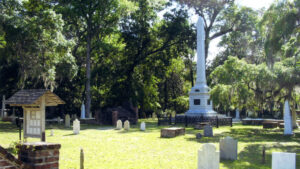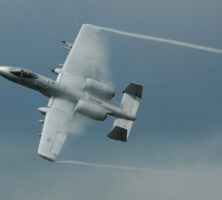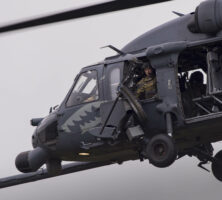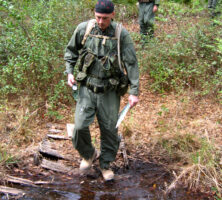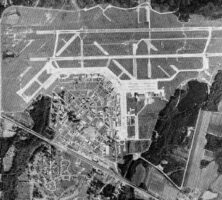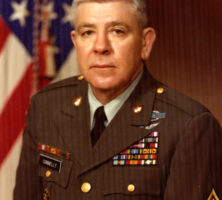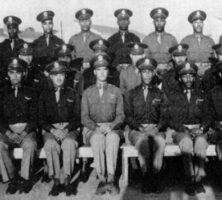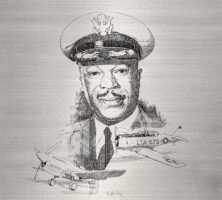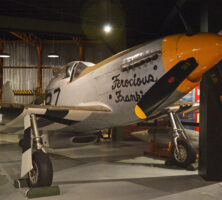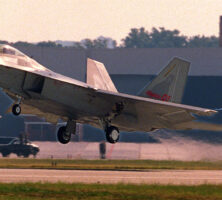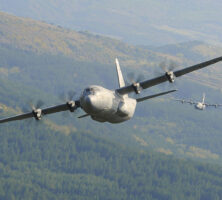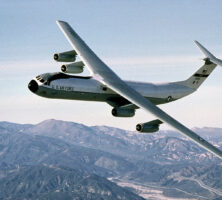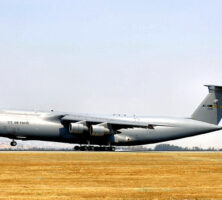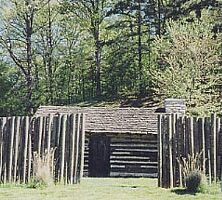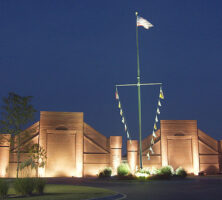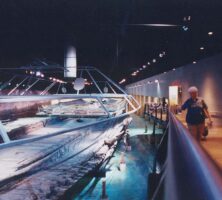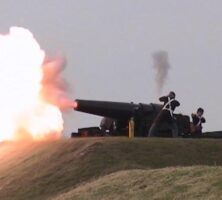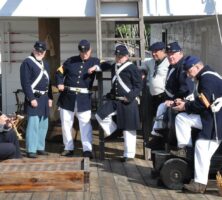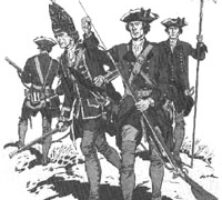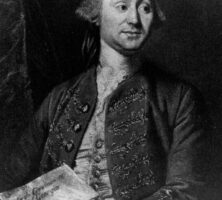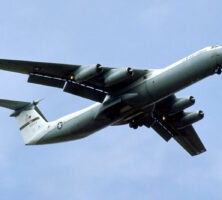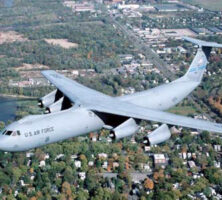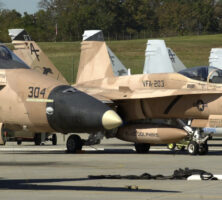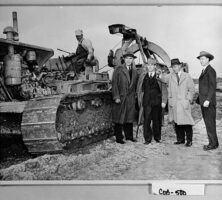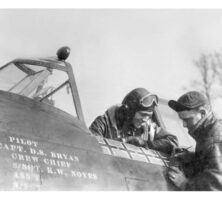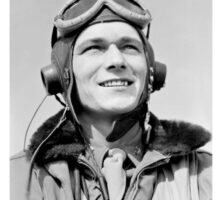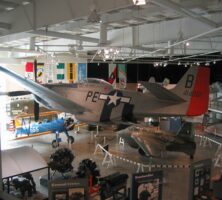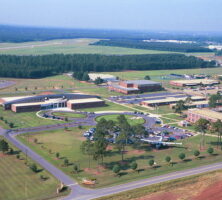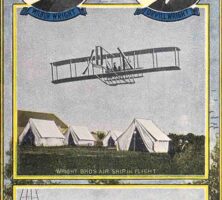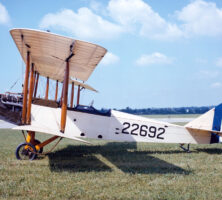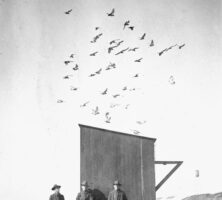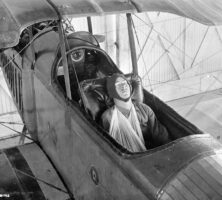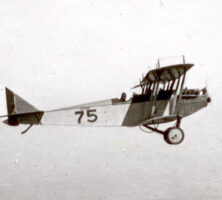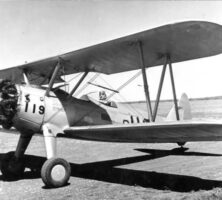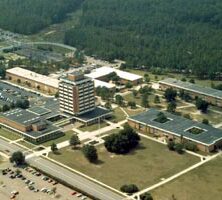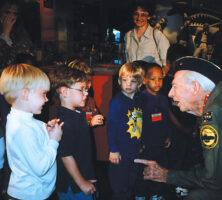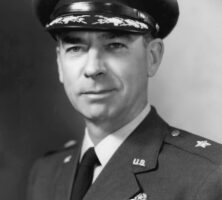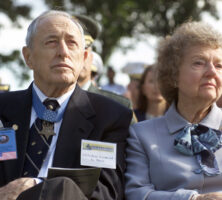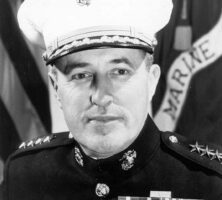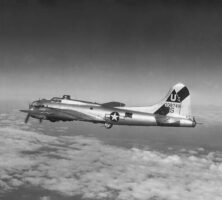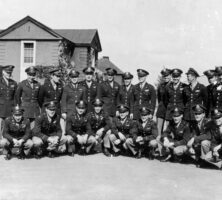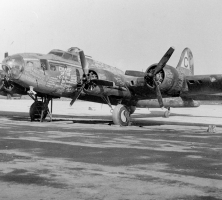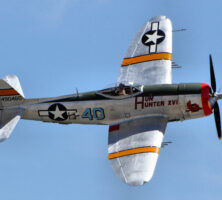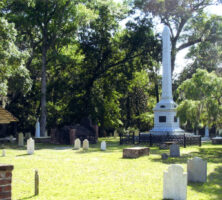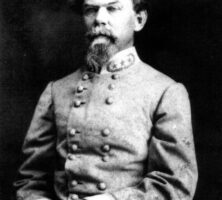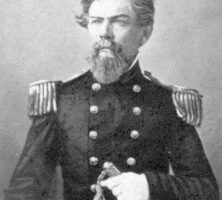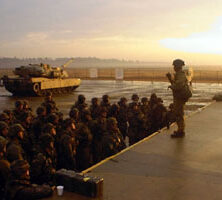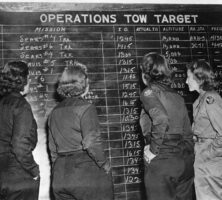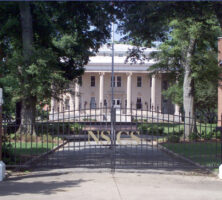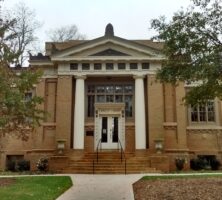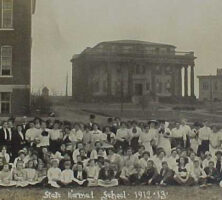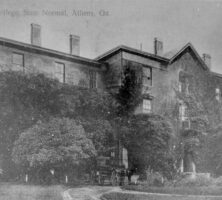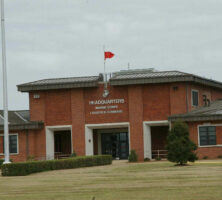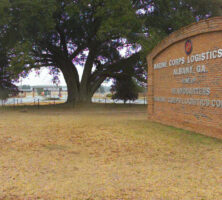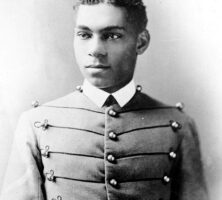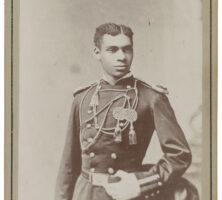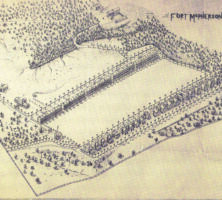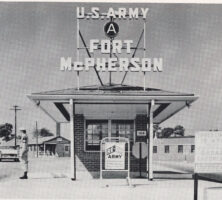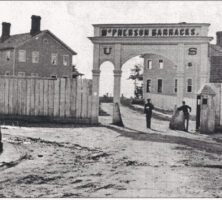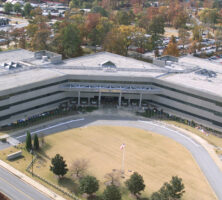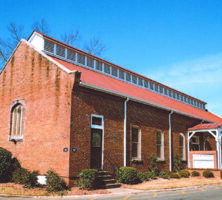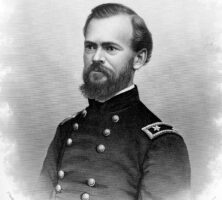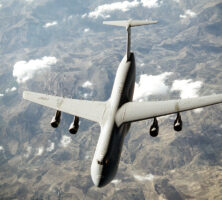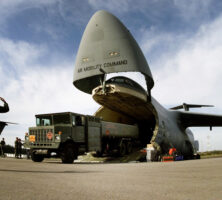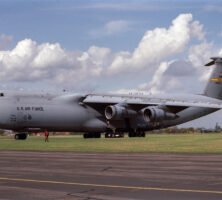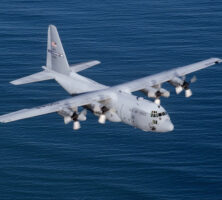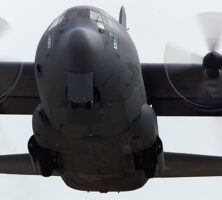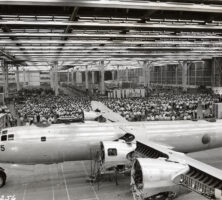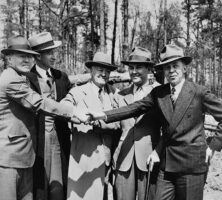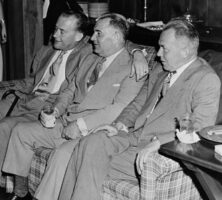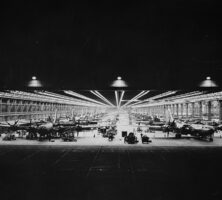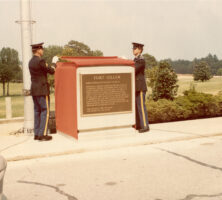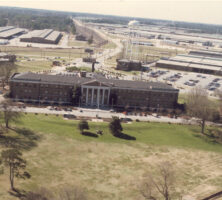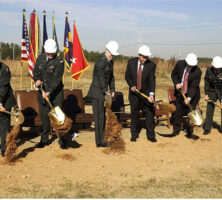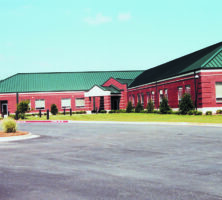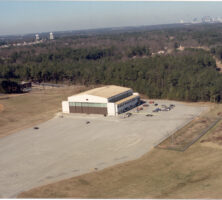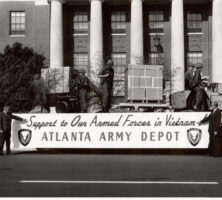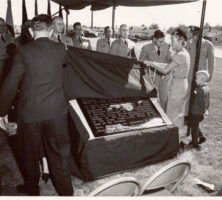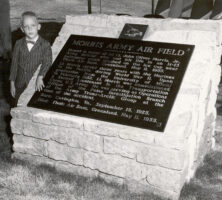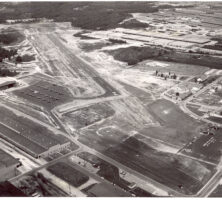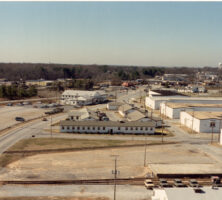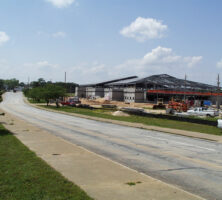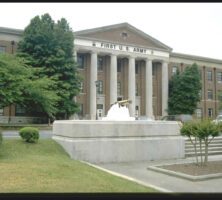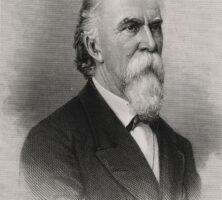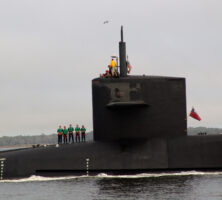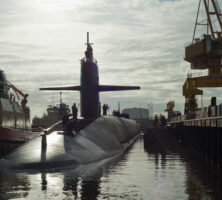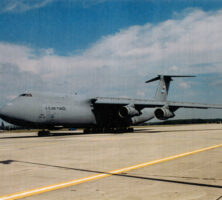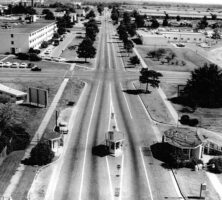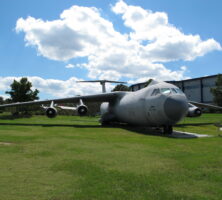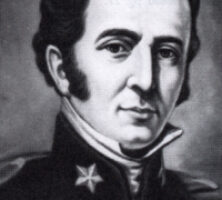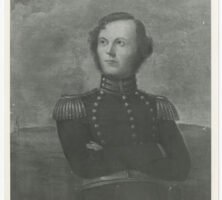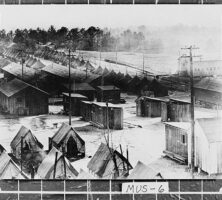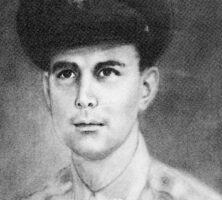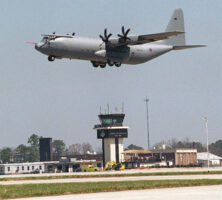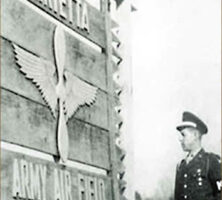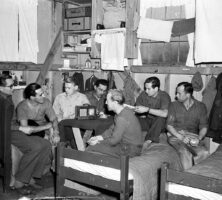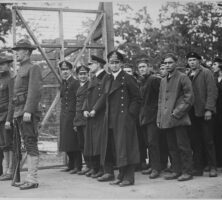The New Georgia Encyclopedia is supported by funding from A More Perfect Union, a special initiative of the National Endowment for the Humanities.
Moody Air Force Base in Lowndes County is home to the A-10 aircraft. The A-10C Thunderbolt II pictured here is equipped with satellite-guided precision weaponry and is used for the air force's search-and-rescue missions.
Courtesy of Moody Air Force Base. Photograph by Parker Gyokeres
The New Georgia Encyclopedia does not hold the copyright for this media resource and can neither grant nor deny permission to republish or reproduce the image online or in print. All requests for permission to publish or reproduce the resource must be submitted to the rights holder.
An HH-60G Pave Hawk helicopter hovers over a field at Moody Air Force Base in Lowndes County. The helicopters are used by the air force to conduct search-and-rescue missions in hostile environments, especially to recover downed aircrew or other isolated military members during war.
Image from U.S. Air Force
The New Georgia Encyclopedia does not hold the copyright for this media resource and can neither grant nor deny permission to republish or reproduce the image online or in print. All requests for permission to publish or reproduce the resource must be submitted to the rights holder.
Airmen from the 41st Rescue Squadron and the 347th Operations Support Squadron, based at Moody Air Force Base, participate in combat survival training in the Grand Bay Wildlife Management Area, near Moody.
Courtesy of Moody Air Force Base. Photograph by Eric Schloeffel
The New Georgia Encyclopedia does not hold the copyright for this media resource and can neither grant nor deny permission to republish or reproduce the image online or in print. All requests for permission to publish or reproduce the resource must be submitted to the rights holder.
Moody Air Force Base in Valdosta is home to the 23d Wing, which includes the 347th Rescue Group. More than 4,600 military and civilian personnel are assigned to the 12,000-acre base.
Courtesy of Beryl I. Diamond
The New Georgia Encyclopedia does not hold the copyright for this media resource and can neither grant nor deny permission to republish or reproduce the image online or in print. All requests for permission to publish or reproduce the resource must be submitted to the rights holder.
Monticello native William A. Connelly served as Sergeant Major of the Army, the highest-ranking noncommissioned officer in the U.S. Army, from 1979 to 1983.
Courtesy of U.S. Army
The New Georgia Encyclopedia does not hold the copyright for this media resource and can neither grant nor deny permission to republish or reproduce the image online or in print. All requests for permission to publish or reproduce the resource must be submitted to the rights holder.
The Tuskegee Airmen (including Charles Dryden) are pictured in late 1943, during World War II. The airmen excelled as bomber escorts, and they flew more than 15,000 combat sorties. Their excellent service led U.S. president Harry S. Truman to desegregate the U.S. military.
Courtesy of Museum of Aviation
The New Georgia Encyclopedia does not hold the copyright for this media resource and can neither grant nor deny permission to republish or reproduce the image online or in print. All requests for permission to publish or reproduce the resource must be submitted to the rights holder.
One of the famed Tuskegee Airmen of World War II, Charles Dryden flew mostly P-40F Warhawks and P-51 Mustangs. A New York native, Dryden moved to Atlanta later in life.
Image from Dsdugan
The New Georgia Encyclopedia does not hold the copyright for this media resource and can neither grant nor deny permission to republish or reproduce the image online or in print. All requests for permission to publish or reproduce the resource must be submitted to the rights holder.
The North American P-51 "Mustang" first entered service in the army air force in 1943. It was one of the most advanced fighters of World War II, serving as an escort for heavy bombers and as an attack and strafing aircraft. It also served in the Korean War.
Image from Alan Wilson
The New Georgia Encyclopedia does not hold the copyright for this media resource and can neither grant nor deny permission to republish or reproduce the image online or in print. All requests for permission to publish or reproduce the resource must be submitted to the rights holder.
The F-22 fighter jet flew for the first time on September 7, 1997, from Dobbins Air Reserve Base in Marietta. At the beginning of this test flight, which lasted more than an hour, the aircraft reached an altitude of 15,000 feet in less than three minutes.
Courtesy of Atlanta Journal-Constitution.
The New Georgia Encyclopedia does not hold the copyright for this media resource and can neither grant nor deny permission to republish or reproduce the image online or in print. All requests for permission to publish or reproduce the resource must be submitted to the Atlanta Journal-Constitution.
The New Georgia Encyclopedia does not hold the copyright for this media resource and can neither grant nor deny permission to republish or reproduce the image online or in print. All requests for permission to publish or reproduce the resource must be submitted to the rights holder.
Compared with earlier models of C-130 Hercules cargo planes, Lockheed Martin's C-130J has a higher cruising altitude and can reach 28,000 feet in fourteen minutes.
Photograph by Wikimedia
The New Georgia Encyclopedia does not hold the copyright for this media resource and can neither grant nor deny permission to republish or reproduce the image online or in print. All requests for permission to publish or reproduce the resource must be submitted to the rights holder.
In the mid-1960s the Lockheed C-141 Starlifter became the first all-jet cargo plane to deploy in the U.S. Air Force. It quickly became the air force's airlift mainstay. Its wide body can accommodate a variety of missions, including personnel and equipment transport, disaster relief, and cargo supplies.
Photograph by Wikimedia
The New Georgia Encyclopedia does not hold the copyright for this media resource and can neither grant nor deny permission to republish or reproduce the image online or in print. All requests for permission to publish or reproduce the resource must be submitted to the rights holder.
One of the biggest aircraft ever made, Lockheed's C-5 Galaxy first flew in 1968. The plane has a wingspan of nearly 223 feet, is 247 feet long and 65 feet high, and can carry 135 tons of cargo.
Photograph from the U.S. Air Force
The New Georgia Encyclopedia does not hold the copyright for this media resource and can neither grant nor deny permission to republish or reproduce the image online or in print. All requests for permission to publish or reproduce the resource must be submitted to the rights holder.
A replica of Fort Peach Tree, which was erected on the banks of the Chattahoochee River in 1814 during the War of 1812, stands in Atlanta. The fort was used as a construction yard for the flatboats that carried shipments along the river to Fort Mitchell, in present-day Alabama.
Courtesy of Susan Barnard
The New Georgia Encyclopedia does not hold the copyright for this media resource and can neither grant nor deny permission to republish or reproduce the image online or in print. All requests for permission to publish or reproduce the resource must be submitted to the rights holder.
The annual "RiverBlast" celebration is held in early March to commemorate the anniversary of the National Civil War Naval Museum at Port Columbus.
Courtesy of National Civil War Naval Museum at Port Columbus
The New Georgia Encyclopedia does not hold the copyright for this media resource and can neither grant nor deny permission to republish or reproduce the image online or in print. All requests for permission to publish or reproduce the resource must be submitted to the rights holder.
The National Civil War Naval Museum at Port Columbus opened its doors in 2001. Located on the Chattahoochee River in Columbus, the museum features Civil War ships and maritime artifacts within its 40,000 square feet.
Courtesy of National Civil War Naval Museum at Port Columbus
The New Georgia Encyclopedia does not hold the copyright for this media resource and can neither grant nor deny permission to republish or reproduce the image online or in print. All requests for permission to publish or reproduce the resource must be submitted to the rights holder.
In 1865 the Union army set fire to the unfinished CSS Jackson and set it adrift in the Chattahoochee River, where it burned for two weeks. The ship was raised in 1961 and is housed today at the National Civil War Naval Museum at Port Columbus.
Courtesy of National Civil War Naval Museum at Port Columbus
The New Georgia Encyclopedia does not hold the copyright for this media resource and can neither grant nor deny permission to republish or reproduce the image online or in print. All requests for permission to publish or reproduce the resource must be submitted to the rights holder.
A Confederate Brooke Rifle is fired regularly outside of the National Civil War Museum at Port Columbus. The gun was built in 1865 at the Confederate Navy Works in Selma, Alabama, and was brought to the Confederate Navy Shipyard in Columbus for use on the CSS Jackson.
Courtesy of National Civil War Naval Museum at Port Columbus
The New Georgia Encyclopedia does not hold the copyright for this media resource and can neither grant nor deny permission to republish or reproduce the image online or in print. All requests for permission to publish or reproduce the resource must be submitted to the rights holder.
Reenactors portraying marines and soldiers are pictured on the replica of the USS during RiverBlast 2010 at the National Civil War Naval Museum at Port Columbus.
Courtesy of National Civil War Naval Museum at Port Columbus
The New Georgia Encyclopedia does not hold the copyright for this media resource and can neither grant nor deny permission to republish or reproduce the image online or in print. All requests for permission to publish or reproduce the resource must be submitted to the rights holder.
James Oglethorpe founded the colony of Georgia in 1733 and built Fort Frederica, which became the center of colonial frontier defense, on St. Simons Island in 1736. Oglethorpe also recruited men from along the colonial milita to form the Rangers, a full-time military force.
Courtesy of Georgia Historical Society, Georgia Historical Society collection of portraits, #GHS 1361-PH-25-08-4841.
The New Georgia Encyclopedia does not hold the copyright for this media resource and can neither grant nor deny permission to republish or reproduce the image online or in print. All requests for permission to publish or reproduce the resource must be submitted to Georgia Historical Society.
Three companies of the British Sixtieth Regiment of Foot were sent to the Georgia colony in 1763 by King George III to strengthen the defense of colonial garrisons against attack by the French and Spanish.
Courtesy of The Company of Military Historians
The New Georgia Encyclopedia does not hold the copyright for this media resource and can neither grant nor deny permission to republish or reproduce the image online or in print. All requests for permission to publish or reproduce the resource must be submitted to the rights holder.
The New Georgia Encyclopedia does not hold the copyright for this media resource and can neither grant nor deny permission to republish or reproduce the image online or in print. All requests for permission to publish or reproduce the resource must be submitted to the rights holder.
James Wright replaced Henry Ellis as royal governor of Georgia in 1760 and proved to be an efficient and popular administrator. During his tenure in office (1760-76) Georgia enjoyed a period of remarkable growth.
Courtesy of Hargrett Rare Book and Manuscript Library, University of Georgia Libraries, Georgia Photo File.
The New Georgia Encyclopedia does not hold the copyright for this media resource and can neither grant nor deny permission to republish or reproduce the image online or in print. Requests for permission to publish or reproduce the resource should be submitted to the Hargrett Manuscript and Rare Book Library at the University of Georgia.
A C-141A Starlifter flies over the Rocky Mountains in 1972. The first C-141A, a troop transport and cargo carrier for the U.S. Air Force, was completed in 1963. The aircraft was designed and built by Lockheed-Georgia in Marietta.
Courtesy of Robins Air Force Base
The New Georgia Encyclopedia does not hold the copyright for this media resource and can neither grant nor deny permission to republish or reproduce the image online or in print. All requests for permission to publish or reproduce the resource must be submitted to the rights holder.
The C-141 Starlifter is a versatile jet aircraft known as the "workhorse" of the U.S. Air Force. Initially introduced in 1963 by Lockheed-Georgia, the aircraft has been updated twice since that time and is used for more than thirty types of transport missions.
Photograph from U.S. Air Force
The New Georgia Encyclopedia does not hold the copyright for this media resource and can neither grant nor deny permission to republish or reproduce the image online or in print. All requests for permission to publish or reproduce the resource must be submitted to the rights holder.
The New Georgia Encyclopedia does not hold the copyright for this media resource and can neither grant nor deny permission to republish or reproduce the image online or in print. All requests for permission to publish or reproduce the resource must be submitted to the rights holder.
The C-141B, a transport aircraft designed in the 1970s at Dobbins Air Force Base in Marietta. Adapted from the earlier C-141A model, the C-141B features a universal air-fueling receptacle that allows for longer nonstop flights.
Image from Rob Schleiffert
The New Georgia Encyclopedia does not hold the copyright for this media resource and can neither grant nor deny permission to republish or reproduce the image online or in print. All requests for permission to publish or reproduce the resource must be submitted to the rights holder.
The C-141C model aircraft was designed during the late 1990s to improve upon the earlier C-141 Starlifter models. Its many technological advancements include a digital autopilot and the All Weather Flight Control System.
Courtesy of Robins Air Force Base
The New Georgia Encyclopedia does not hold the copyright for this media resource and can neither grant nor deny permission to republish or reproduce the image online or in print. All requests for permission to publish or reproduce the resource must be submitted to the rights holder.
F-18 fighter jets wait on the flight line of the Naval Air Station at Dobbins Air Reserve Base in Marietta. The Hornets first arrived at the air station in the early 1990s, with Fighter Attack Squadron 203.
Courtesy of Atlanta Journal-Constitution.
The New Georgia Encyclopedia does not hold the copyright for this media resource and can neither grant nor deny permission to republish or reproduce the image online or in print. All requests for permission to publish or reproduce the resource must be submitted to the Atlanta Journal-Constitution.
In 1955 Congress appropriated more than $4 million to build a facility in Marietta that would allow for longer runways than those at Naval Air Station Atlanta in Chamblee. Construction was completed in 1959. Pictured, from left, are Eddie Richebacker, James V. Carmichael, L. M. "Rip" Blair, and George McMillan.
Courtesy of Georgia Archives, Vanishing Georgia, #
cob500.
The New Georgia Encyclopedia does not hold the copyright for this media resource and can neither grant nor deny permission to republish or reproduce the image online or in print. Requests for permission to publish or reproduce the resource should be submitted to the Georgia Archives.
Pilots Donald Bryan (left) and K. W. Noyes paint crosses on their Republic P-47 Thunderbolt on February 24, 1944. The crosses represent victories in battle by the pilots, who served as escorts for bombers in Germany during World War II.
Courtesy of 352nd Fighter Group Association, and Sam Sox Jr. Archivist
The New Georgia Encyclopedia does not hold the copyright for this media resource and can neither grant nor deny permission to republish or reproduce the image online or in print. All requests for permission to publish or reproduce the resource must be submitted to the rights holder.
Donald Bryan was a captain in the Eighth Army Air Force (or "Mighty Eighth") when this photograph was taken on November 2, 1944, in Bodney, England. On this day Bryan downed five enemy aircraft, for which he was awarded the Distinguished Service Cross.
Courtesy of 352nd Fighter Group Association, and Sam Sox Jr. Archivist
The New Georgia Encyclopedia does not hold the copyright for this media resource and can neither grant nor deny permission to republish or reproduce the image online or in print. All requests for permission to publish or reproduce the resource must be submitted to the rights holder.
A replica of the P-51 flown by Donald Bryan during World War II is displayed at the Mighty Eighth Air Force Museum near Savannah. The P-51 was a technologically advanced plane used to escort bombers on missions over German territory.
Courtesy of Mighty Eighth Air Force Museum
The New Georgia Encyclopedia does not hold the copyright for this media resource and can neither grant nor deny permission to republish or reproduce the image online or in print. All requests for permission to publish or reproduce the resource must be submitted to the rights holder.
Souther Field's concrete runways are visible in the upper left of this photograph. In the foreground is South Georgia Technical College, which now occupies the grassy field where Charles Lindbergh conducted his solo takeoff and landing as well as his many practice flights. Souther Field Road (formerly Souther Road) is visible at the bottom right and borders the college.
Courtesy of Jerry Stovall, South Georgia Technical College
The New Georgia Encyclopedia does not hold the copyright for this media resource and can neither grant nor deny permission to republish or reproduce the image online or in print. All requests for permission to publish or reproduce the resource must be submitted to the rights holder.
This postcard depicts the Wright brothers' Military Flyer, first flown in 1909. The development of this plane marks the beginning of U.S. military aviation. In World War I, the demands of battle dictated many uses for flying machines, including reconnaissance, bomb deployment, and the pursuit and attack of other planes.
The New Georgia Encyclopedia does not hold the copyright for this media resource and can neither grant nor deny permission to republish or reproduce the image online or in print. All requests for permission to publish or reproduce the resource must be submitted to the rights holder.
The Standard biplane was used for training by the U.S. Army. The first plane to take off and land at Souther Field, in 1917, was a Standard.
Image from U.S. Air Force
The New Georgia Encyclopedia does not hold the copyright for this media resource and can neither grant nor deny permission to republish or reproduce the image online or in print. All requests for permission to publish or reproduce the resource must be submitted to the rights holder.
Carrier pigeons and a pigeon house at Souther Field, in Sumter County, in 1918. Souther Field was constructed as a military flight-training facility, and the pigeons were used to transmit messages before the development of sophisticated communications systems.
Courtesy of Georgia Archives, Vanishing Georgia, #
sum041.
The New Georgia Encyclopedia does not hold the copyright for this media resource and can neither grant nor deny permission to republish or reproduce the image online or in print. Requests for permission to publish or reproduce the resource should be submitted to the Georgia Archives.
Pictured in 1918, a wounded soldier awaits transport in a hospital airplane at Souther Field in Sumter County. Souther Field, a military aviation training facility, is today known as Jimmy Carter Regional Airport.
Courtesy of Georgia Archives, Vanishing Georgia, #
sum034.
The New Georgia Encyclopedia does not hold the copyright for this media resource and can neither grant nor deny permission to republish or reproduce the image online or in print. Requests for permission to publish or reproduce the resource should be submitted to the Georgia Archives.
A JN-4 Jenny flies vertically as a "wing walker" jumps from the plane. The walker is wearing a parachute, which he will wait to deploy until he is very near the ground. Such aerial stunts, referred to as "barnstorming," were performed by famous pilot Charles Lindbergh when he was first learning to fly in 1922.
Image by George Johnson, Aviation Section, U.S. Army Signal Corps
The New Georgia Encyclopedia does not hold the copyright for this media resource and can neither grant nor deny permission to republish or reproduce the image online or in print. All requests for permission to publish or reproduce the resource must be submitted to the rights holder.
The Boeing Stearman PT-17 was the primary flight-training airplane of World War II. Built similarly to those flown at Souther Field, this PT-17 was photographed in Texas during World War II. At the controls sits an aviation cadet.
Courtesy of Scott Hedgland
The New Georgia Encyclopedia does not hold the copyright for this media resource and can neither grant nor deny permission to republish or reproduce the image online or in print. All requests for permission to publish or reproduce the resource must be submitted to the rights holder.
Fort Gordon, located southwest of Augusta, opened in December 1941, after the Japanese bombing of Pearl Harbor in Hawaii during World War II. The installation was named in honor of Confederate general John B. Gordon.
Courtesy of U.S. Army Signal Corps Museum
The New Georgia Encyclopedia does not hold the copyright for this media resource and can neither grant nor deny permission to republish or reproduce the image online or in print. All requests for permission to publish or reproduce the resource must be submitted to the rights holder.
The New Georgia Encyclopedia does not hold the copyright for this media resource and can neither grant nor deny permission to republish or reproduce the image online or in print. All requests for permission to publish or reproduce the resource must be submitted to the rights holder.
The New Georgia Encyclopedia does not hold the copyright for this media resource and can neither grant nor deny permission to republish or reproduce the image online or in print. All requests for permission to publish or reproduce the resource must be submitted to the rights holder.
The New Georgia Encyclopedia does not hold the copyright for this media resource and can neither grant nor deny permission to republish or reproduce the image online or in print. All requests for permission to publish or reproduce the resource must be submitted to the rights holder.
The New Georgia Encyclopedia does not hold the copyright for this media resource and can neither grant nor deny permission to republish or reproduce the image online or in print. All requests for permission to publish or reproduce the resource must be submitted to the rights holder.
The New Georgia Encyclopedia does not hold the copyright for this media resource and can neither grant nor deny permission to republish or reproduce the image online or in print. All requests for permission to publish or reproduce the resource must be submitted to the rights holder.
The story of General Robert Scott (right), a famed member of the American Volunteer Group, or the "Flying Tigers," is part of an exhibition on World War II at the Museum of Aviation in Warner Robins. Scott was involved extensively in the museum's development and served as a museum docent from the mid-1980s until his death in 2006.
Courtesy of the Museum of Aviation
The New Georgia Encyclopedia does not hold the copyright for this media resource and can neither grant nor deny permission to republish or reproduce the image online or in print. All requests for permission to publish or reproduce the resource must be submitted to the rights holder.
Robert Scott, a World War II flying ace, published God Is My Co-Pilot, a best-selling memoir of his experiences, in 1943.
Image from U.S. Air Force
The New Georgia Encyclopedia does not hold the copyright for this media resource and can neither grant nor deny permission to republish or reproduce the image online or in print. All requests for permission to publish or reproduce the resource must be submitted to the rights holder.
As a lieutenant colonel during the Korean War, Raymond Davis and his battalion saved the lives of thousands of fellow marines surrounded by Chinese soldiers at the Chosin Reservoir. Davis returned to combat during the Vietnam War as a major general.
Image from U.S. Navy
The New Georgia Encyclopedia does not hold the copyright for this media resource and can neither grant nor deny permission to republish or reproduce the image online or in print. All requests for permission to publish or reproduce the resource must be submitted to the rights holder.
Raymond G. Davis, who served in the Marine Corps during World War II and the Korean and Vietnam wars, was decorated many times during his military career. Among his numerous awards are the Congressional Medal of Honor, the Navy Cross, and the Purple Heart.
Image from Korean War Medal of Honor recipients
The New Georgia Encyclopedia does not hold the copyright for this media resource and can neither grant nor deny permission to republish or reproduce the image online or in print. All requests for permission to publish or reproduce the resource must be submitted to the rights holder.
By August 1942 the Mighty Eighth Air Force was flying missions in the Boeing B-17 Flying Fortress.
Courtesy of Family of Lt. Patrick A. Walls
The New Georgia Encyclopedia does not hold the copyright for this media resource and can neither grant nor deny permission to republish or reproduce the image online or in print. All requests for permission to publish or reproduce the resource must be submitted to the rights holder.
The personnel of the 84th Fighter Squadron, a unit of the Eighth Air Force, posing in Duxford in the summer of 1944.
Image from United States Army Air Forces
The New Georgia Encyclopedia does not hold the copyright for this media resource and can neither grant nor deny permission to republish or reproduce the image online or in print. All requests for permission to publish or reproduce the resource must be submitted to the rights holder.
The New Georgia Encyclopedia does not hold the copyright for this media resource and can neither grant nor deny permission to republish or reproduce the image online or in print. All requests for permission to publish or reproduce the resource must be submitted to the rights holder.
An early model B-17, such as the "Knock Out Dropper," was a challenge to pilot because the contol column and rudder pedals required great strength to operate and because the cabins lacked heat and pressurization.
Image from United States Army Air Forces
The New Georgia Encyclopedia does not hold the copyright for this media resource and can neither grant nor deny permission to republish or reproduce the image online or in print. All requests for permission to publish or reproduce the resource must be submitted to the rights holder.
The New Georgia Encyclopedia does not hold the copyright for this media resource and can neither grant nor deny permission to republish or reproduce the image online or in print. All requests for permission to publish or reproduce the resource must be submitted to the rights holder.
The P-47 Thunderbolt was a superior World War II fighter, evolving through several modifications. It was ideally suited to both escort and ground attack roles. The plane's bulbous appearance gave it the nickname "the Jug."
Image from Airwolfhound
The New Georgia Encyclopedia does not hold the copyright for this media resource and can neither grant nor deny permission to republish or reproduce the image online or in print. All requests for permission to publish or reproduce the resource must be submitted to the rights holder.
The New Georgia Encyclopedia does not hold the copyright for this media resource and can neither grant nor deny permission to republish or reproduce the image online or in print. All requests for permission to publish or reproduce the resource must be submitted to the rights holder.
The Midway Congregational Church Cemetery was listed on the National Register of Historic Places in 1973. Among those buried here are James Screven and Daniel Stewart, two American generals of the Revolutionary War. A large monument in the center of the cemetery was dedicated in 1915 to these two men.
Courtesy of Winston E. Walker III
The New Georgia Encyclopedia does not hold the copyright for this media resource and can neither grant nor deny permission to republish or reproduce the image online or in print. All requests for permission to publish or reproduce the resource must be submitted to the rights holder.
Confederate lieutenant general William J. Hardee fought in major battles in Kentucky, Tennessee, and Georgia throughout the Civil War. His army eventually surrendered after one last charge near Bentonville, South Carolina, in March 1865.
Courtesy of National Archives and Records Administration
The New Georgia Encyclopedia does not hold the copyright for this media resource and can neither grant nor deny permission to republish or reproduce the image online or in print. All requests for permission to publish or reproduce the resource must be submitted to the rights holder.
William J. Hardee's 1855 textbook, Rifle and Light Infantry Tactics, was required reading for officers in both the Union and Confederate armies. Achieving the rank of lieutenant general in the Confederate army, Hardee was renowned for his understanding of tactical maneuvers in battle.
Courtesy of Georgia Historical Society, Georgia Historical Society collection of photographs, #GHS 1361PH-24-12-4738.
The New Georgia Encyclopedia does not hold the copyright for this media resource and can neither grant nor deny permission to republish or reproduce the image online or in print. All requests for permission to publish or reproduce the resource must be submitted to Georgia Historical Society.
A unit commander addresses his soldiers in the early morning hours on Red Cloud Range, Fort Stewart, 2002.
Courtesy of United States Army
The New Georgia Encyclopedia does not hold the copyright for this media resource and can neither grant nor deny permission to republish or reproduce the image online or in print. All requests for permission to publish or reproduce the resource must be submitted to the rights holder.
The New Georgia Encyclopedia does not hold the copyright for this media resource and can neither grant nor deny permission to republish or reproduce the image online or in print. All requests for permission to publish or reproduce the resource must be submitted to the rights holder.
The New Georgia Encyclopedia does not hold the copyright for this media resource and can neither grant nor deny permission to republish or reproduce the image online or in print. All requests for permission to publish or reproduce the resource must be submitted to the rights holder.
The New Georgia Encyclopedia does not hold the copyright for this media resource and can neither grant nor deny permission to republish or reproduce the image online or in print. All requests for permission to publish or reproduce the resource must be submitted to the rights holder.
Women's Airforce Service Pilots (WASPs) at Liberty Field, Camp Stewart, circa 1944. WASPs flew planes towing antiaircraft targets out of Liberty Field during World War II.
Image from National Museum of the U.S. Air Force
The New Georgia Encyclopedia does not hold the copyright for this media resource and can neither grant nor deny permission to republish or reproduce the image online or in print. All requests for permission to publish or reproduce the resource must be submitted to the rights holder.
The New Georgia Encyclopedia does not hold the copyright for this media resource and can neither grant nor deny permission to republish or reproduce the image online or in print. All requests for permission to publish or reproduce the resource must be submitted to the rights holder.
The New Georgia Encyclopedia does not hold the copyright for this media resource and can neither grant nor deny permission to republish or reproduce the image online or in print. All requests for permission to publish or reproduce the resource must be submitted to the rights holder.
Officers in training stand in formation outside of Winnie Davis Hall on the campus of the Navy Supply Corps School, which was located in Athens from 1954 until 2010.
Courtesy of the United States Navy
The New Georgia Encyclopedia does not hold the copyright for this media resource and can neither grant nor deny permission to republish or reproduce the image online or in print. All requests for permission to publish or reproduce the resource must be submitted to the rights holder.
From 1954 until 2010, all active-duty supply corps officers in the U.S. Navy were trained at the Navy Supply Corps School in Athens. In 2010 the school relocated to Newport, Rhode Island, and in 2012 the UGA Health Sciences Campus opened on the Athens site.
Courtesy of the United States Navy
The New Georgia Encyclopedia does not hold the copyright for this media resource and can neither grant nor deny permission to republish or reproduce the image online or in print. All requests for permission to publish or reproduce the resource must be submitted to the rights holder.
Housed in a former Carnegie Library building (built circa 1910), the Navy Supply Corps Museum was located on the campus of the Navy Supply Corps School, which operated in Athens from 1954 until 2010.
Image from RFoxx
The New Georgia Encyclopedia does not hold the copyright for this media resource and can neither grant nor deny permission to republish or reproduce the image online or in print. All requests for permission to publish or reproduce the resource must be submitted to the rights holder.
Teachers at the State Normal School in Athens are pictured circa 1912. The U.S. Navy purchased the normal school site in 1953 and the following year opened the Navy Supply Corps School, which remained in Athens until 2010.
Courtesy of the United States Navy
The New Georgia Encyclopedia does not hold the copyright for this media resource and can neither grant nor deny permission to republish or reproduce the image online or in print. All requests for permission to publish or reproduce the resource must be submitted to the rights holder.
Old Rock College, State Normal, Athens, Ga. The State Normal School for women was located in the section of Athens now known as Normaltown.
Courtesy of the United States Navy
The New Georgia Encyclopedia does not hold the copyright for this media resource and can neither grant nor deny permission to republish or reproduce the image online or in print. All requests for permission to publish or reproduce the resource must be submitted to the rights holder.
Headquarters of the Marine Corps Logistics Base, located in Dougherty County in southwest Georgia, approximately five miles southeast of Albany.
Photograph by Corporal Andrew Roufs
The New Georgia Encyclopedia does not hold the copyright for this media resource and can neither grant nor deny permission to republish or reproduce the image online or in print. All requests for permission to publish or reproduce the resource must be submitted to the rights holder.
The Dubber Oak, the tree upon which the base was aligned during construction, still stands near the Marine Corps Logistics Base main gate. The oak is named for Colonel "A" "E" Dubber, the officer who chose the Albany site and insisted on preserving wildlife and trees during its development.
Photograph by Lance Corporal Kevin Ridlon
The New Georgia Encyclopedia does not hold the copyright for this media resource and can neither grant nor deny permission to republish or reproduce the image online or in print. All requests for permission to publish or reproduce the resource must be submitted to the rights holder.
Henry O. Flipper, pictured circa 1877, was the first African American to graduate and receive his commission from the U.S. Military Academy at West Point, New York. A native of Thomasville, Flipper attended Atlanta University for one year before enrolling at West Point.
Courtesy of U.S Military Academy at West Point
The New Georgia Encyclopedia does not hold the copyright for this media resource and can neither grant nor deny permission to republish or reproduce the image online or in print. All requests for permission to publish or reproduce the resource must be submitted to the rights holder.
Henry O. Flipper was the first African American to graduate from the U.S. Military Academy at West Point in New York.
Courtesy of National Archives and Records Administration.
Most government records are in the public domain. Please consult the National Archives and Records Administration for more information.
Early plan of Fort McPherson, which was located in southeast Atlanta from 1885 until 2011.
Courtesy of Fort McPherson
The New Georgia Encyclopedia does not hold the copyright for this media resource and can neither grant nor deny permission to republish or reproduce the image online or in print. All requests for permission to publish or reproduce the resource must be submitted to the rights holder.
The old Lee Street gate of Fort McPherson is pictured in 1960. The installation, which occupied nearly 500 acres in southeast Atlanta from 1885 to 2011, was one of the largest command centers in the U.S. military.
Courtesy of Fort McPherson
The New Georgia Encyclopedia does not hold the copyright for this media resource and can neither grant nor deny permission to republish or reproduce the image online or in print. All requests for permission to publish or reproduce the resource must be submitted to the rights holder.
Historical photograph of the entrance to the barracks at Fort McPherson, located in southeast Atlanta from 1885 until 2011.
Courtesy of the Army in Atlanta Museum
The New Georgia Encyclopedia does not hold the copyright for this media resource and can neither grant nor deny permission to republish or reproduce the image online or in print. All requests for permission to publish or reproduce the resource must be submitted to the rights holder.
The headquarters for U.S. Army Forces Command (FORSCOM), housed in a 356,000-square-foot complex covering five acres at Fort McPherson, was the workplace of some 2,000 military and civilian employees. The fort closed in 2011, and FORSCOM moved to Fort Bragg, North Carolina.
Courtesy of Garrison Public Affairs Office, Fort McPherson
The New Georgia Encyclopedia does not hold the copyright for this media resource and can neither grant nor deny permission to republish or reproduce the image online or in print. All requests for permission to publish or reproduce the resource must be submitted to the rights holder.
The chapel at Fort McPherson, an army command center located south of Atlanta from 1885 until 2011.
Courtesy of Garrison Public Affairs Office, Fort McPherson
The New Georgia Encyclopedia does not hold the copyright for this media resource and can neither grant nor deny permission to republish or reproduce the image online or in print. All requests for permission to publish or reproduce the resource must be submitted to the rights holder.
This engraving depicts Major General James McPherson, for whom Fort McPherson in southeast Atlanta was named. The Union general was killed in action during the Battle of Atlanta on July 22, 1864.
From The History of the State of Georgia, by I. W. Avery
The New Georgia Encyclopedia does not hold the copyright for this media resource and can neither grant nor deny permission to republish or reproduce the image online or in print. All requests for permission to publish or reproduce the resource must be submitted to the rights holder.
The Lockheed-Georgia C-5 Galaxy can carry 135 tons of cargo, making it the largest production aircraft built in the United States and a vital part of any military action in which large amounts of material need to be airlifted around the world. It has a wingspan of just under 223 feet and is 247 feet long and 65 feet high.
The New Georgia Encyclopedia does not hold the copyright for this media resource and can neither grant nor deny permission to republish or reproduce the image online or in print. All requests for permission to publish or reproduce the resource must be submitted to the rights holder.
At both ends of the C-5 Galaxy aircraft large doors can swing open to the cargo deck, and two rows of vehicles can drive on and off at the same time.
The New Georgia Encyclopedia does not hold the copyright for this media resource and can neither grant nor deny permission to republish or reproduce the image online or in print. All requests for permission to publish or reproduce the resource must be submitted to the rights holder.
The airframe of a C-5 Galaxy that has received structural upgrades will maintain its integrity for an estimated 50,000 flight hours before being retired. This means that many of the planes now in service can keep flying until past 2060.
The New Georgia Encyclopedia does not hold the copyright for this media resource and can neither grant nor deny permission to republish or reproduce the image online or in print. All requests for permission to publish or reproduce the resource must be submitted to the rights holder.
The high tail of the C-130 Hercules allows room for a large cargo door that lowers to form a ramp. With a length of 97 feet and wingspan of 132 feet, the C-130J can carry up to 46,631 pounds. In troop transport configuration, it can accommodate 92 combat troops or 64 paratroopers. The aircraft can fly up to 2,729 miles and has a maximum speed of 417 miles per hour.
The New Georgia Encyclopedia does not hold the copyright for this media resource and can neither grant nor deny permission to republish or reproduce the image online or in print. All requests for permission to publish or reproduce the resource must be submitted to the rights holder.
With a wide fuselage, distinctive high tail, and multiwheeled landing gear, the C-130 Hercules is one of the most versatile and rugged transport aircraft ever built. Beyond its role as a versatile cargo and troop transport, C-130s are used as bombers, cannon-firing gunships, hurricane hunters, aerial refueling tankers, air ambulances, firefighters, and even aerial sprayers.
The New Georgia Encyclopedia does not hold the copyright for this media resource and can neither grant nor deny permission to republish or reproduce the image online or in print. All requests for permission to publish or reproduce the resource must be submitted to the rights holder.
A B-29 bomber being assembled at the Bell Aircraft Corporation, circa 1943.
Courtesy of Atlanta History Center.
The New Georgia Encyclopedia does not hold the copyright for this media resource and can neither grant nor deny permission to republish or reproduce the image online or in print. Requests for permission to publish or reproduce the resource should be submitted to the Atlanta History Center.
The New Georgia Encyclopedia does not hold the copyright for this media resource and can neither grant nor deny permission to republish or reproduce the image online or in print. All requests for permission to publish or reproduce the resource must be submitted to the rights holder.
(Left to right) Frank Shaw of the Atlanta Chamber of Commerce, Cobb County commissioner George McMillan, Atlanta Chamber representative Ivan Allen Sr., county attorney James V. Carmichael, and Marietta mayor Rip Blair pose for publicity pictures at the groundbreaking of Bell Bomber on April 2, 1942.
Courtesy of Georgia Archives, Vanishing Georgia, # cob496a.
The New Georgia Encyclopedia does not hold the copyright for this media resource and can neither grant nor deny permission to republish or reproduce the image online or in print. Requests for permission to publish or reproduce the resource should be submitted to the Georgia Archives.
The New Georgia Encyclopedia does not hold the copyright for this media resource and can neither grant nor deny permission to republish or reproduce the image online or in print. All requests for permission to publish or reproduce the resource must be submitted to the rights holder.
(Left to right) James V. Carmichael, general manager of the Bell Aircraft Corporation; Lawrence D. Bell, founder and president of Bell Aircraft; and Leon M. Blair, mayor of Marietta, enjoy a party at Blair's home in 1949. Carmichael holds a cane, which he walked with for most of his life, after being struck by a car at age sixteen.
Courtesy of Georgia Archives, Vanishing Georgia, #cob497a.
The New Georgia Encyclopedia does not hold the copyright for this media resource and can neither grant nor deny permission to republish or reproduce the image online or in print. Requests for permission to publish or reproduce the resource should be submitted to the Georgia Archives.
The New Georgia Encyclopedia does not hold the copyright for this media resource and can neither grant nor deny permission to republish or reproduce the image online or in print. All requests for permission to publish or reproduce the resource must be submitted to the rights holder.
Bell Aircraft Corporation built B-29 bombers at its Marietta, Georgia, plant during World War II.
Courtesy of Georgia Archives, Vanishing Georgia, # cob202.
The New Georgia Encyclopedia does not hold the copyright for this media resource and can neither grant nor deny permission to republish or reproduce the image online or in print. Requests for permission to publish or reproduce the resource should be submitted to the Georgia Archives.
Two members of the U.S. Army Forces Command Color Guard unveil the plaque dedicating Fort Gillem, formerly the Atlanta Army Depot, during activation ceremonies held on June 28, 1974. The fort was named in honor of Lieutenant General Alvan C. Gillem Jr., former commander of the Third U.S. Army.
Courtesy of Garrison Public Affairs Office, Fort McPherson
The New Georgia Encyclopedia does not hold the copyright for this media resource and can neither grant nor deny permission to republish or reproduce the image online or in print. All requests for permission to publish or reproduce the resource must be submitted to the rights holder.
In 1995 the First U.S. Army was reorganized at Fort Gillem, in Forest Park. First Army headquarters, building 101, sat on a small hill above the sprawling base, which closed in 2011.
Courtesy of Garrison Public Affairs Office, Fort McPherson
The New Georgia Encyclopedia does not hold the copyright for this media resource and can neither grant nor deny permission to republish or reproduce the image online or in print. All requests for permission to publish or reproduce the resource must be submitted to the rights holder.
The groundbreaking for a new forensics laboratory at Fort Gillem was held on November 25, 2002. From left to right, Major General Donald J. Ryder; Colonel Harold E. Cooney; Lieutenant Colonel William S. Schaff Jr.; Larry Chelko, director of the laboratory; William A. Story, president of Beers Skanska, Inc.; and Colonel Roger A. Gerber.
Courtesy of Garrison Public Affairs Office, Fort McPherson
The New Georgia Encyclopedia does not hold the copyright for this media resource and can neither grant nor deny permission to republish or reproduce the image online or in print. All requests for permission to publish or reproduce the resource must be submitted to the rights holder.
This 28,000-square-foot building opened on January 13, 2000, to house the Military Entrance Processing Station at Fort Gillem. The base closed in 2011.
Courtesy of Garrison Public Affairs Office, Fort McPherson
The New Georgia Encyclopedia does not hold the copyright for this media resource and can neither grant nor deny permission to republish or reproduce the image online or in print. All requests for permission to publish or reproduce the resource must be submitted to the rights holder.
Morris Army Air Field Hangar at Fort Gillem was completed in early September 1959. It contained 20,000 square feet of floor space and was built at a cost of $500,000. The hangar was demolished in 2002.
Courtesy of Garrison Public Affairs Office, Fort McPherson
The New Georgia Encyclopedia does not hold the copyright for this media resource and can neither grant nor deny permission to republish or reproduce the image online or in print. All requests for permission to publish or reproduce the resource must be submitted to the rights holder.
Soldiers at the Atlanta Army General Depot in 1967 show their support of the troops in Vietnam.
Courtesy of Garrison Public Affairs Office, Fort McPherson
The New Georgia Encyclopedia does not hold the copyright for this media resource and can neither grant nor deny permission to republish or reproduce the image online or in print. All requests for permission to publish or reproduce the resource must be submitted to the rights holder.
The New Georgia Encyclopedia does not hold the copyright for this media resource and can neither grant nor deny permission to republish or reproduce the image online or in print. All requests for permission to publish or reproduce the resource must be submitted to the rights holder.
John O. Morris Sr. and Virginia A. Morris unveil a monument at Morris Army Airfield dedicated to 1st Lieutenant John O. Morris Jr. on September 22, 1959. The airfield was part of the Atlanta General Depot (later Fort Gillem) in Forest Park.
Courtesy of Garrison Public Affairs Office, Fort McPherson
The New Georgia Encyclopedia does not hold the copyright for this media resource and can neither grant nor deny permission to republish or reproduce the image online or in print. All requests for permission to publish or reproduce the resource must be submitted to the rights holder.
Kirk Morris, son of 1st Lieutenant John O. Morris Jr., stands next to the monument dedicated to his father at Morris Army Airfield on September 22, 1959. The airfield was located at the Atlanta General Depot, which later became Fort Gillem, in Clayton County. Both the airfield and the fort are now closed.
Courtesy of Garrison Public Affairs Office, Fort McPherson
The New Georgia Encyclopedia does not hold the copyright for this media resource and can neither grant nor deny permission to republish or reproduce the image online or in print. All requests for permission to publish or reproduce the resource must be submitted to the rights holder.
Morris Army Airfield, pictured in the early 1960s, was an airstrip and aircraft repair facility at the Atlanta General Depot (later Fort Gillem) in Forest Park. Construction started on the airfield in August 1958, and the facility was dedicated on September 22, 1959.
Courtesy of Garrison Public Affairs Office, Fort McPherson
The New Georgia Encyclopedia does not hold the copyright for this media resource and can neither grant nor deny permission to republish or reproduce the image online or in print. All requests for permission to publish or reproduce the resource must be submitted to the rights holder.
The west end of Fort Gillem near Iverson Gate is pictured in 1990. The 2nd Recruiting Brigade building is the two-story building on the left. On the right are warehouses. The base, which was located in Clayton County, closed in 2011.
Courtesy of Garrison Public Affairs Office, Fort McPherson
The New Georgia Encyclopedia does not hold the copyright for this media resource and can neither grant nor deny permission to republish or reproduce the image online or in print. All requests for permission to publish or reproduce the resource must be submitted to the rights holder.
Construction of a reserve center complex at Fort Gillem in Forest Park is pictured in 2001. Built near Iverson Gate on Hood Avenue, the completed complex included an army reserve center building, medical warehouse, maintenance storage, army reserve vehicle maintenance shop, and supply storage building. The base closed in 2011.
Courtesy of Garrison Public Affairs Office, Fort McPherson
The New Georgia Encyclopedia does not hold the copyright for this media resource and can neither grant nor deny permission to republish or reproduce the image online or in print. All requests for permission to publish or reproduce the resource must be submitted to the rights holder.
The First U.S. Army was headquartered at Fort Gillem, in Clayton County, from 1995 until the base's closure in 2011.
Courtesy of Garrison Public Affairs Office, Fort McPherson
The New Georgia Encyclopedia does not hold the copyright for this media resource and can neither grant nor deny permission to republish or reproduce the image online or in print. All requests for permission to publish or reproduce the resource must be submitted to the rights holder.
Major General Henry Rootes Jackson is best known for organizing and commanding Georgia troops during the Atlanta campaign of the Civil War.
From The History of the State of Georgia, by I. W. Avery
The New Georgia Encyclopedia does not hold the copyright for this media resource and can neither grant nor deny permission to republish or reproduce the image online or in print. All requests for permission to publish or reproduce the resource must be submitted to the rights holder.
A return-to-service ceremony for the USS Georgia, a guided-missile submarine converted from a ballistic-missile submarine, was held at Kings Bay Naval Submarine Base in Camden County on March 28, 2008.
Photograph by Mass Communication Specialist 2nd Class Regina L. Brown. Courtesy of the United States Navy
The New Georgia Encyclopedia does not hold the copyright for this media resource and can neither grant nor deny permission to republish or reproduce the image online or in print. All requests for permission to publish or reproduce the resource must be submitted to the rights holder.
The Kings Bay Naval Submarine Base, located at St. Marys on the south Georgia coast, is the home port for the Atlantic Fleet's most modern nuclear ballistic submarines, the Trident or Ohio-class subs.
Image from Submarine Group Ten
The New Georgia Encyclopedia does not hold the copyright for this media resource and can neither grant nor deny permission to republish or reproduce the image online or in print. All requests for permission to publish or reproduce the resource must be submitted to the rights holder.
The New Georgia Encyclopedia does not hold the copyright for this media resource and can neither grant nor deny permission to republish or reproduce the image online or in print. All requests for permission to publish or reproduce the resource must be submitted to the rights holder.
The New Georgia Encyclopedia does not hold the copyright for this media resource and can neither grant nor deny permission to republish or reproduce the image online or in print. All requests for permission to publish or reproduce the resource must be submitted to the rights holder.
The first C-5 at Robins Air Force Base, pictured in 1997.
Courtesy of William P. Head, WR-ALC Office of History
The New Georgia Encyclopedia does not hold the copyright for this media resource and can neither grant nor deny permission to republish or reproduce the image online or in print. All requests for permission to publish or reproduce the resource must be submitted to the rights holder.
The New Georgia Encyclopedia does not hold the copyright for this media resource and can neither grant nor deny permission to republish or reproduce the image online or in print. All requests for permission to publish or reproduce the resource must be submitted to the rights holder.
Known as the Georgia Air Depot in the beginning, the depot has undergone many name changes. During World War II it was redesignated seven times, acquiring "Warner Robins" in the fifth version of its name, when the town of Wellston was renamed to honor General Robins.
Courtesy of William P. Head, WR-ALC Office of History
The New Georgia Encyclopedia does not hold the copyright for this media resource and can neither grant nor deny permission to republish or reproduce the image online or in print. All requests for permission to publish or reproduce the resource must be submitted to the rights holder.
The Warner Robins Air Logistics Center at the base manages such military aircraft as the C-141B/C Starlifter, the F-15 Eagle, the C-5 Galaxy, and the C-130 Hercules.
Image from Kelly Michals
The New Georgia Encyclopedia does not hold the copyright for this media resource and can neither grant nor deny permission to republish or reproduce the image online or in print. All requests for permission to publish or reproduce the resource must be submitted to the rights holder.
On March 14, 1836, Colonel James Walker Fannin Jr. was ordered by Texas president Sam Houston to withdraw from Goliad to Victoria, but he delayed until the 19th. As Fannin's regiment withdrew, it was surrounded by a Mexican force under General Jose de Urrea. Fannin and his volunteers were imprisoned and subsequently massacred.
The New Georgia Encyclopedia does not hold the copyright for this media resource and can neither grant nor deny permission to republish or reproduce the image online or in print. All requests for permission to publish or reproduce the resource must be submitted to the rights holder.
Colonel James Walker Fannin Jr. distinguished himself in a number of skirmishes during the Texas Independence movement. He commanded the group of Georgia volunteers and Texans massacred at Goliad, Texas, on March 27, 1836.
The New Georgia Encyclopedia does not hold the copyright for this media resource and can neither grant nor deny permission to republish or reproduce the image online or in print. Requests for permission to publish or reproduce the resource should be submitted to the Hargrett Manuscript and Rare Book Library at the University of Georgia.
A locomotive is displayed outside the old National Infantry Museum at Fort Benning, near Columbus. The museum, comprising numerous artifacts related to the U.S. Infantry, became part of the new National Infantry Museum and Soldier Center in 2009.
Courtesy of Georgia Department of Economic Development.
The New Georgia Encyclopedia does not hold the copyright for this media resource and can neither grant nor deny permission to republish or reproduce the image online or in print. Requests for permission to publish or reproduce the resource may need to be submitted to the Georgia Department of Economic Development.
Camp Benning in Columbus, shown circa 1919.
Courtesy of Georgia Archives, Vanishing Georgia, #
mus006.
The New Georgia Encyclopedia does not hold the copyright for this media resource and can neither grant nor deny permission to republish or reproduce the image online or in print. Requests for permission to publish or reproduce the resource should be submitted to the Georgia Archives.
The National Infantry Museum and Soldier Center opened in 2009, just outside the gates of Fort Moore. The museum commemorates the contributions of the U.S. Infantry throughout history. The facility also features an IMAX movie theater, a gift shop, and a restaurant.
Courtesy of National Infantry Museum and Soldier Center
The New Georgia Encyclopedia does not hold the copyright for this media resource and can neither grant nor deny permission to republish or reproduce the image online or in print. All requests for permission to publish or reproduce the resource must be submitted to the rights holder.
Captain Charles M. Dobbins, from whom Dobbins Air Reserve Base takes its name, was a pilot assigned to an air force paratroopers division during World War II. He was reported missing in action on July 11, 1943, when his plane failed to return to its North African base from a raid on Sicily, Italy. Dobbins was never seen again.
Courtesy of Georgia National Guard
The New Georgia Encyclopedia does not hold the copyright for this media resource and can neither grant nor deny permission to republish or reproduce the image online or in print. All requests for permission to publish or reproduce the resource must be submitted to the rights holder.
On its first test flight in 1996, Lockheed-Martin's C-130J lifted off from Dobbins Air Reserve Base in Marietta. The plane, built for the Royal Air Force of Great Britain, remained in the air for about two hours.
Courtesy of Atlanta Journal-Constitution.
The New Georgia Encyclopedia does not hold the copyright for this media resource and can neither grant nor deny permission to republish or reproduce the image online or in print. All requests for permission to publish or reproduce the resource must be submitted to the Atlanta Journal-Constitution.
A military policeman is pictured circa 1943 at the entrance to Marietta Army Air Field, which later became Dobbins Air Reserve Base.
Courtesy of Georgia National Guard
The New Georgia Encyclopedia does not hold the copyright for this media resource and can neither grant nor deny permission to republish or reproduce the image online or in print. All requests for permission to publish or reproduce the resource must be submitted to the rights holder.
In Macon and Dublin POW camps, German prisoners of World War II were treated well and given plenty of leisure time. In many cases, these inmates retained a strong sense of camaraderie.
Courtesy of Special Collections & Archives, Georgia State University Library, Tracy O'Neal Photographic Collection.
The New Georgia Encyclopedia does not hold the copyright for this media resource and can neither grant nor deny permission to republish or reproduce the image online or in print. Requests for permission to publish or reproduce the resource should be submitted to Special Collections and Archives at Georgia State University.
The New Georgia Encyclopedia does not hold the copyright for this media resource and can neither grant nor deny permission to republish or reproduce the image online or in print. All requests for permission to publish or reproduce the resource must be submitted to the rights holder.
The officers and crew of the German submarine U.58, captured by the U.S.S. Fanning, enter the War Prison Camp at Fort McPherson, 1918.
Courtesy of National Archives and Records Administration.
Most government records are in the public domain. Please consult the National Archives and Records Administration for more information.
